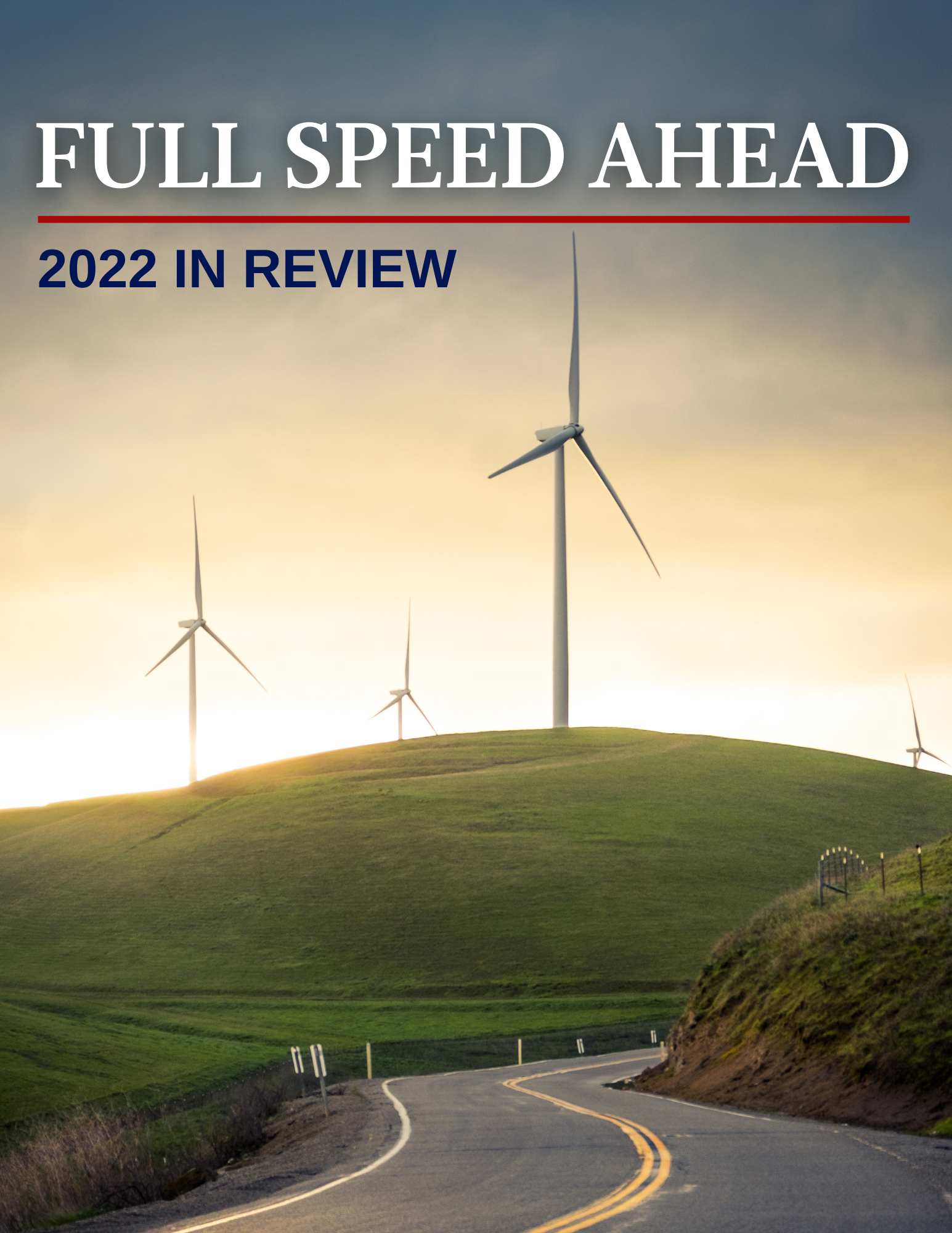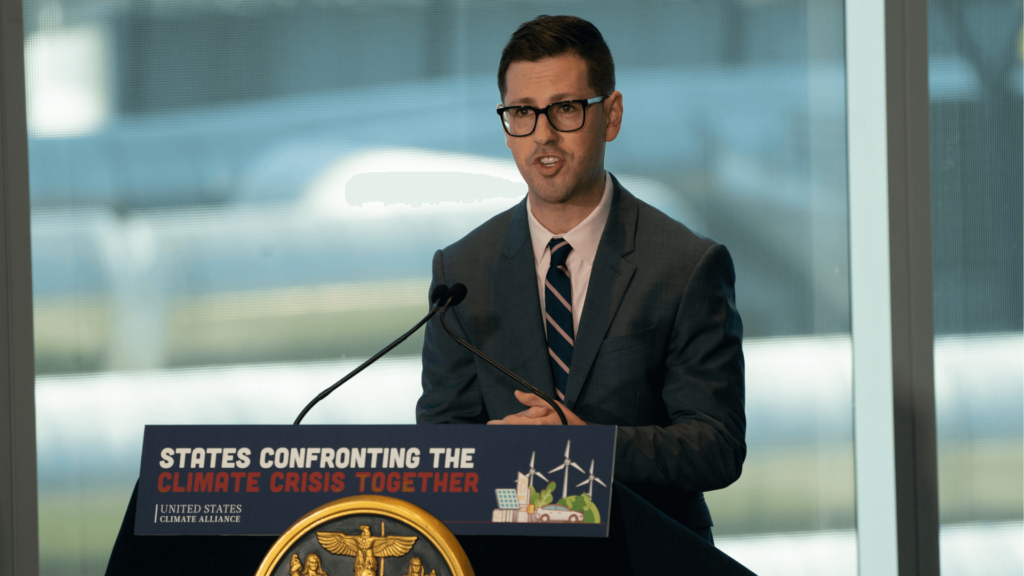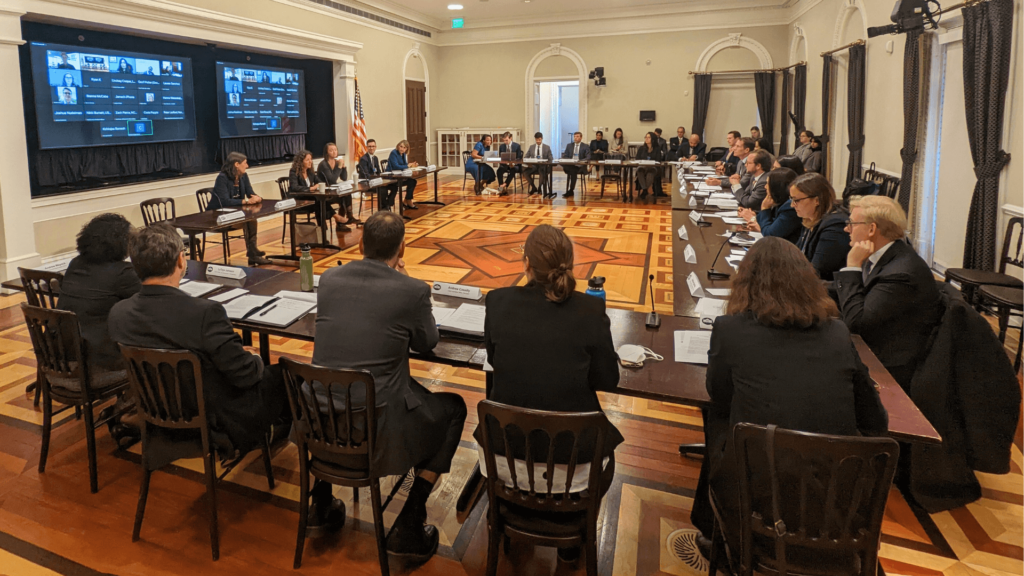Home / Full Speed Ahead: 2022 in Review

As an action-packed year comes to a close, the U.S. Climate Alliance is taking a look back. In 2022, we moved full speed ahead — we announced new leadership and grew our team, celebrated our coalition’s 5-year anniversary, helped secure passage of the largest climate and clean energy investments in U.S. history, spotlighted state climate action at Climate Week NYC and COP27, and published new resources to cut emissions across sectors. Below, we highlight a few of these key moments and reflect on the enormous progress we’ve made. We can’t wait to carry this momentum into 2023.

Just before Earth Day, the Alliance named Casey Katims Executive Director and promoted Taryn Finnessey to Managing Director, marking a new era of leadership at the Alliance Secretariat. Katims joined after serving as EPA’s Deputy Associate Administrator for Intergovernmental Relations and as Washington Governor Jay Inslee’s Director of Federal and Inter-State Affairs, and Finnessey previously served as the Alliance’s Policy Director and Acting Executive Director.
The Alliance also grew its team throughout the year, adding new staff with a focus on climate infrastructure and Inflation Reduction Act implementation, state energy policy, and communications and digital media.
This summer marked five years since the governors of Washington, New York, and California formed the Alliance in response to the previous administration’s decision to yank the United States from the Paris Agreement. Since then, the Alliance has grown to include two dozen U.S. governors from every region of the country and has built a foundation of ambitious climate action for states across the country, as well as the federal government.
To mark the anniversary, Alliance governors and federal officials shared a series of video messages. Watch them here.

The Alliance this year deepened its partnership with the Biden Administration to lock in progress across government, responded forcefully to the harmful Supreme Court decision in West Virginia v EPA, and, importantly, played a key role in securing passage of the Inflation Reduction Act to deploy the most significant climate and clean energy investments in U.S. history. Following a call by Alliance governors in June to urge swift congressional action on climate, the Alliance celebrated passage of the Inflation Reduction Act in August. The bill makes meaningful investments in state climate action, providing critical resources to accelerate state leadership in tackling greenhouse gas emissions and protecting Americans from climate impacts. In 2023, states and territories will be instrumental in delivering on the promise of the Inflation Reduction Act.
Governors and state officials brought the Alliance’s message to the national and international stages again in 2022, showcasing ambitious state-led action during both Climate Week NYC and COP27.
In September, as the world’s leaders gathered for the UN General Assembly and Climate Week NYC, Governors Kathy Hochul (NY) and Phil Murphy (NJ) hosted a press conference at the Javits Center in New York City to highlight how Alliance states are accelerating climate action at home while collaborating on bold and innovative solutions with their fellow states. Both states made significant announcements at the event—raising ambition for large-scale renewable energy projects in New York and increasing offshore wind goals by nearly 50 percent in New Jersey.
More recently, last month at COP27 in Sharm El Sheikh, Egypt, the Alliance convened and participated in more than half a dozen events, as well as bilateral and multilateral meetings. Events featured Governors Inslee and Lujan Grisham, White House National Climate Advisor Ali Zaidi, Council on Environmental Quality Chair Brenda Mallory, and U.S. Department of Energy Secretary Jennifer Granholm, among others. In addition to the governors, top Alliance state officials from California, Hawai‘i, Washington, New Jersey, and New Mexico also participated in events across COP27.
Throughout 2022, the Alliance continued to bolster its resources and tools to support state-led climate action across sectors and policy areas. New guides on the Social Cost of Greenhouse Gases (SC-GHG), just and equitable transition policies, natural and working lands, and industrial decarbonization help Alliance states learn from one another, overcome barriers and challenges, and fill critical knowledge gaps.
Additionally, the Alliance released its 2022 Annual Report in September, which found that Alliance states and territories are achieving lower levels of air pollution, delivering more energy savings to homes and businesses, employing more clean energy workers, preparing more effectively for climate impacts and disasters, and generating a higher proportion of electricity from zero-carbon sources than the rest of the country while centering equity and resilience.
As states push to deliver innovative, high-impact climate actions, the Alliance will continue to ensure they have every tool at their disposal. Read all Alliance publications here.
Implementation was a central theme at COP27 and will continue to be critical to state climate action in the year ahead. The Inflation Reduction Act has the potential to reduce emissions, improve public health, save consumers money, create more jobs, and advance equity—and the role of states in delivering these benefits can’t be overstated. State-level ambition and action will be critical to helping the U.S. reach its broader climate goals and accelerate progress toward our net-zero future. The U.S. midterm elections reaffirmed the importance of climate action and leadership at the state level, and we look forward to welcoming a number of new governors into our coalition and continuing to build on this momentum in the year ahead.
Launched in 2017 by the governors of Washington, New York, and California to help fill the void left by the U.S. federal government’s withdrawal from the Paris Agreement, the Alliance has grown to include 24 governors from across the U.S. representing approximately 60 percent of the U.S. economy and 55 percent of the U.S. population. Governors in the Alliance have pledged to collectively reduce net greenhouse gas emissions by at least 26-28 percent by 2025, 50-52 percent by 2030, and 61-66 percent by 2035, all below 2005 levels, and collectively achieve overall net-zero greenhouse gas emissions as soon as practicable, and no later than 2050.
The Alliance’s states and territories continue to advance innovative and impactful climate solutions to grow the economy, create jobs, and protect public health, and have a long record of action and results. In fact, the latest data shows that as of 2023, the Alliance has reduced its collective net greenhouse gas emissions by 24 percent below 2005 levels, while increasing collective GDP by 34 percent, and is on track to meet its near-term climate goal of reducing collective greenhouse gas emissions 26 percent below 2005 levels by 2025.
###